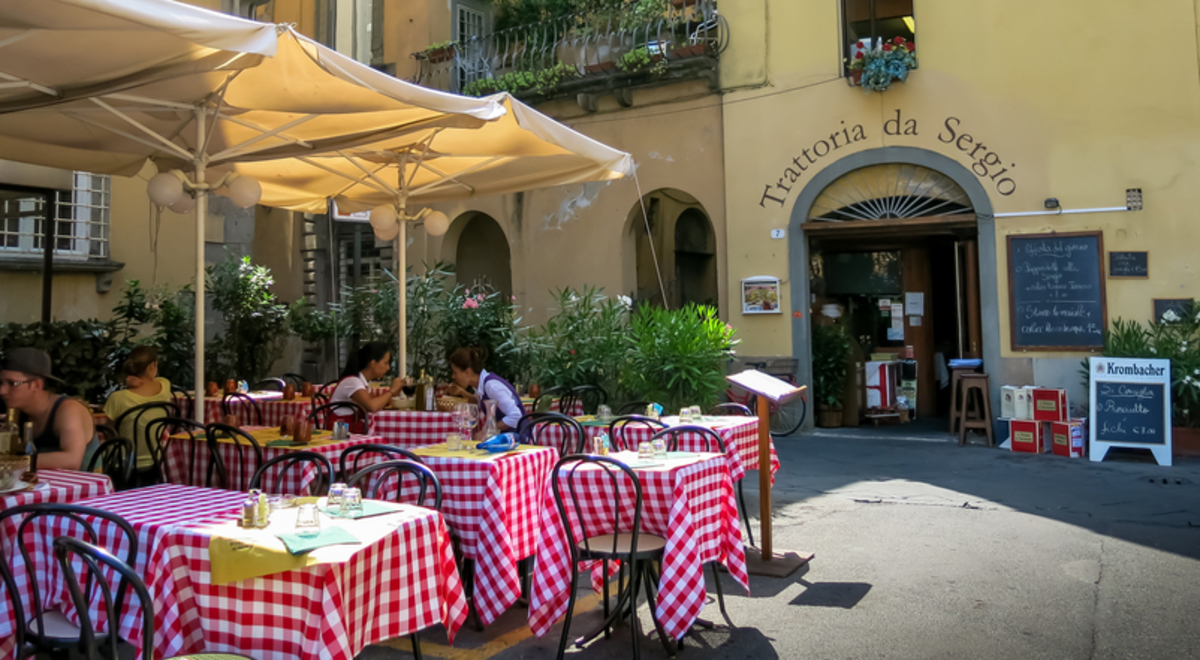Florence, Venice and Rome are worth seeing, but all over Italy there are smaller cities worth a visit too. Alexia Santamaria visits Lucca, a lovely walled city that does double duty as a base for exploring the gorgeous countryside of Tuscany.
A restaurant on Piazza Bernadini, Lucca. Photo: iStock
There is a magical time in June in Tuscany when the weather is warm but towns aren’t yet flooded with hordes of tourists. I was lucky enough to visit Lucca, just north of Pisa, in that golden period and it was wonderful. If you're travelling in Italy, Lucca is worth a stop: not only is it an enchanting walled city filled with tiny alleyways, cobble-stoned streets, shops, restaurants and bars, it's also an ideal base for day trips into the surrounding area.
Having just escaped the glorious madness of Rome, we spent most of our time in Lucca in meander mode. All over the town are remnants of its long and fascinating history, beginning with the Etruscans and later the Romans, who founded a colony here in 180 BC. The historical centre lies within red brick walls built in the 16th and 17th Century as a defence against the rapacious dukes of nearby Florence. On the top of the walls there is a circular path – more a wide tree-lined pedestrian avenue, really – which is perfect for walking or cycling. We hired bikes and loved the elevated perspective. If you're still feeling energetic, more good views can be had by climbing the steps to the top of Torre delle Ore or Torre Guinigi.
A view of Lucca, from the Torre Guinigi (Guinigi Tower). Photo: Alexia Santamaria
Lucca's most famous son is the composer Puccini, and opera lovers should make time to visit his childhood home. There are too many art galleries, churches and museums in Lucca to even mention – you could lose yourself in wonderful art and culture here for days.
On the whole, the food was excellent and we appreciated not needing to be so careful of tourist traps in many bigger Italian cities. For lunch, we'd buy made-to-order focaccia sandwiches overflowing with juicy tomatoes, oil-preserved eggplant and artichokes, and pillowy-fresh mozzarella. A dining highlight was the authentic Italian experience and hearty home-cooked food at Trattoria da Leo. The matriarch is an Italian mamma straight out of a movie and eating there is lots of noisy fun. Between meals, we developed an unhealthy obsession with the gelato and the pastries sold from shops on almost every corner, especially the cornetto alla crema, a cone of crisp pastry filled with luscious custard cream.
A delicatessen, or alimentari, in Lucca. Photo: Alexia Santamaria
We could easily have spent many lazy days wandering Lucca's streets, interspersing cultural visits with stops for wine, antipasto and gelato. But we wanted to explore further afield, so we took our lives in our hands and hired a car. Driving in Italy is really not that bad, actually. You do need to be a confident driver because the Italians travel at speed and according to road rules only they seem to know. As long as you don’t hesitate, you’re fine.
We'd heard the densely wooded area known as the Garfagnana was worth a look so we drove north through the Serchio Valley, sandwiched between the Apuane Alps and the Apennine Mountains, and watched the countryside transform from Tuscan terracotta to green, green and greener. Halfway up the valley we stopped at the mad-looking Ponte del Diavolo (Devil's Bridge), which dates from the 11th Century. From the top you get gorgeous view of the sparkling River Serchio with the Apennines in the background. We continued up to San Pellegrino on some wildly winding roads, an exhilarating drive with spectacular views.
Ponte del Diavolo, Tuscany. Photo: Alexia Santamaria
The Garfagnana's lush, green landscape is dotted with enchanting villages and forts that have remained unchanged for centuries. We took breaks at Castiglione di Garfagnana, a small but fascinating stronghold with a preserved fortress, and Castelnuovo di Garfagnana, the biggest town in the region with a marvellous castle and cathedral. They were both worth the stop.
Another great day trip from Lucca is Carrara. Before visiting this part of the country I hadn't really thought about where all that marble for Italy's stonework, statues and sculpture originally came from. But driving around here, surrounded by enormous sheer-white mountain faces, it soon became apparent. A trip to the quarries at Carrara is a fascinating experience, and once we got over our fear of crazy Italian truck drivers transporting massive Flintstone-esque blocks of marble, it was even better. At Fantiscritti, just outside Carrara, we took a 4WD tour of the working quarry, passing places where the opening scenes of the James Bond movie Quantum of Solace were filmed. At the top of the mountain we were rewarded with an amazing view out to the coast and beyond, the bright blue Mediterranean Sea.
Fantiscritti quarry, Carrara. Photo: Alexia Santamaria
It's mind-boggling to watch the extraction of this magnificent stone and even more confounding to think that for thousands of years it was done without modern machinery and transport. To think, Carrara marble was used in parts of the construction of the forum in Rome – that's over 400 km away!
Another day, we headed to the spa town of Montecatini Terme. It's a charming place with plenty of pretty gardens and picturesque avenues. There's an old-fashioned cable car that whisks you up to Montecatini Alto, a medieval hillside settlement, some really lovely shops and, of course, the thermal baths. People come here to drink the supposedly healing waters from the town's hydro-mineral basin 60-80 metres below ground. Tettuccio Terme, where you go to drink, was built in the late 18th Century by the Grand Duke of Hapsburg, and the place is certainly fit for royalty, a lavishly decorated place full of Renaissance paintings, Roman mosaic floors, and Italianate gardens. The idea is to drink the water and wander round the gardens, letting it digest.
Tettuccio Terme, Tuscany. Photo: Alexia Santamaria
If you want to actually bathe – soaking in the water is supposedly excellent for rheumatic and vascular ailments – options include the nearby Thermae Redi. It's a much more modern place than Tettuccio, very clean, and it also offers massage, yoga and pilates. Thermae Excelsior, also close by, has every beauty, body and spa therapy imaginable. Between the baths, the excellent shopping and the sweet treats at local pastry shop Pasticceria Pellegrini, I could have happily whiled away days in Montecatini.
If you're looking for a relaxing Italian holiday, with plenty of good eating, Lucca and the surrounding region is a great choice. Take the plunge, hire a car and get out and explore Tuscany, home to some of the most beautiful countryside in Italy.












